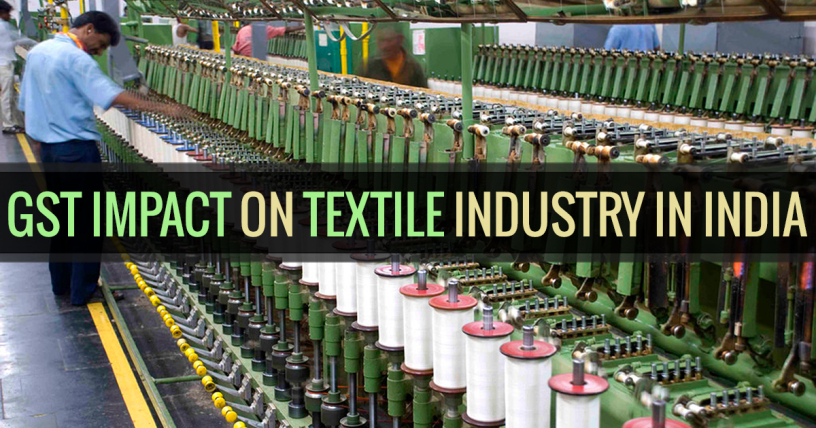TEXTILE INDUSTRY AND THE GOODS AND SERVICE TAX
Textile industries are vital in the development of the Indian economy, basically with respect to Export promotion, employment, GDP, etc. It is India’s one of the oldest manufacturing industry and the second largest industry after agriculture which provides both skilled and unskilled employment. 100% FDI is allowed by the Government under the Automatic Route to this sector.
The Indian textiles and apparel industry contributes nearly, 2% to India’s Gross Domestic Product (GDP), 10% to manufacturing production and constitutes 13% of country’s export earnings. The industry, currently estimated at around $ 108 billion, is expected to reach nearly $ 223 billion by 2021. It has been enjoying various tax exemptions, concessions under indirect taxes.
For textile industry, the Central excise duty was first introduced in year 2001 but for woven garments only. It was then extended to entire textile industry by 2003. The excise duty exemption option was also provided by notification no.30/2004 but in 2011, mandatory excise duty was reintroduced and then removed in 2013. Later, in 2016, mandatory excise duty has been re-introduced again on branded readymade garments.
In Goods and Sales Tax (GST) regime, most of the indirect taxes such as central excise duty, service tax, Value Added Tax, Sales tax and entry tax would get subsumed. For textile and its products, the expected GST rate of 5%. But if the rate is declared at 12%, then it could have a negative impact because the textile industry is price sensitive. Paying 12% GST would be costlier as presently; there is 1.2 % excise duty + 5% to 6% of VAT which amounts to 6 to 7.2% tax. Cotton may continue to get exemption in GST regime.
It may be noted that other materials such as packing materials, dyes, chemicals accessories etc. which constitutes around 8% to 12% of total material cost could be liable for standard GST of 18% which is eligible as input tax credit when output GST is paid.
IMPACT OF GST ON TEXTILE SECTOR
As per the recommendation by the Dr. Arvind Subramanian Committee if we consider 12% rate, the textile sector is likely to be negatively impacted. The cotton value chain is likely to be the worst affected as it is currently attracting zero central excise duty and tax in inputs may not be more than 2-4%.
- Improved compliances
A remarkable effect of GST would be to improve compliance. The value chain under the GST will be fully traceable and will automatically lead to higher revenues.
- Revenue Neutral rate (RNR) proposed to be higher under GST
CGST and SGST rates are likely to be higher than the existing textile sector rate. This will lead to higher revenue to the Central and State Governments leading to increase in Textile Prices.
Also, there will a reduced tax advantage of cotton yarn as compared to man-made yarn, there can be a gradual shift from domestic textile industry towards manmade fibres.
- Fiscal barriers for inter-state movement will be removed
- Promote Capital investment
- Transparent Taxation
Textile players which are oriented towards domestic markets will be able to set-off the GST paid on domestic capital goods. This is basically due to the reason that their sales will be subject to GST. This will lead to reduction of the cost of capital investment which will further be positive for the players operating in domestic markets.
- No discrimination of Goods
- Duty Drawback to lose relevance:
With Input tax credit chain becoming much more integrated and transparent and hence, the tax credit for exporters will become simpler and easier. Also, full credit of indirect taxes can be claimed but the duty drawback scheme could lose relevance under GST.
- Increase in administrative cost
SOME NEGATIVE IMPACT ON TEXTILE INDUSTRY
- Goods Transfers as Stock:
Transfer of Goods from one place to another place will be liable for GST if it’s inter-state trade. If separate dealerships are obtained with separate GST registration number, then any transfer of supply between such dealerships will also be liable for Goods and Sales Tax.
- Advance Booking:
As this sector requires advance booking of Goods so that market demands are met, which is done on payment of certain amount considering as token money with no VAT is not being paid on such advances, in GST System Tax one has to pay on advance received for booking
- Road Tax/ Environment Tax:
In the GST System, GST must also include Road Tax, while presently, Service tax or VAT is not paid on the Road Tax element.
- Post Supply Discounts:
Various discounts received by dealers from its manufacturers based on targets, goods lifted etc will not be allowed as deduction from the value if the same is not linked to any invoice in the GST return.
- Related Party Transactions:
Transaction value can be rejected if the transaction is with any related party or if the same is with any of its other entity with separate GST Number.

